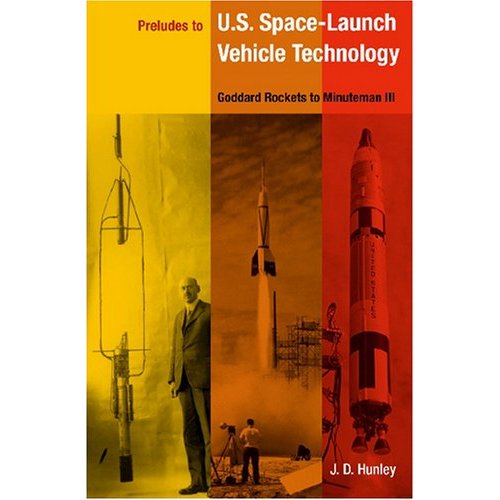[/caption]
A simple lesson in school physics provides the fundamental theory behind rockets. Simply put, by quickly pushing lots of exhaust out, the great mass of a rocket will ascend. Yet, as is often the case, putting theory into practise is anything but simple. J.D. Hunley in his book ‘Preludes to U.S. Space-Launch Vehicle Technology – Goddard Rockets to Minuteman III‘ presents the many painful, exciting steps that made this technological marvel a practical mode of transport. The reader will find that rocket theory is fine, but it’s through the engineering that people have really shown the height to which they can arise.
As rocket aficionados know, Tsiolkovsky first put theory to paper. But, it was Goddard and Oberth who tried and tried again to push objects up further than any had gone before. Though neither of these two made much progress, they did make believers of many others. As more people jumped on the band wagon, comprehensive knowledge accumulated. Swapping propellant types, materials and designs made for an optimized product. And, through enough trial and error, rocket theory became rocket practice.
Hunley’s book recounts the trials and errors from the US. It moves the reader through the developing technology and, by maintaining a technical focus for the duration, it keeps a steady course. The book does introduce many names, companies and defense department branches. But, through it all, the technology reigns. The reader comes across the importance of rate gyros, accelerometers, dry grain extrusions, and fuel baffles. The reader sees how the V2 program was absorbed into existing rocket programs and how all programs competed against and shared with each other. With the book later splitting technology coverage to separately review liquid fuel and solid fuel propellants, the reader can understand the shifts and accomplishments of each. Through the book’s continuous listing of trials, errors, fixes and more trials, the reader will come to appreciate the incredible effort that people expanded to acquire the skill and particular knowledge with which to efficiently and reliably launch a great mass into space. Yet, as it shows and as we’ve all seen, rocket technology still can keep us guessing.
Nevertheless, rocket technology hasn’t progressed much from its early days. For many years, we’ve likely had or known of the best propellants, the best material and the best design. So, should a curious person wonder why thrust chambers are gimballed, this book has an answer. Should they wonder what the rocket program ever provided society, this book shows the main-streaming of materials, circuit based computers, and program management. Should a person wonder about the route taken to arrive at the reliable launchers of today, this book shows the path. Without being too specific or detailed, this book looks at each major launch vehicle from the 1930s up to the 1970s with respect to structure, engines, guidance and control, testing and development. If you’re wondering about the subsequent years, stay tuned. The follow-on book concludes the review with an assessment of Viking to Space Shuttle launch vehicles.
As Robert Goddard might have come to realize, one person’s lifetime is insufficient to develop and build reliable rockets. As J.D. Hunley shows in his book ‘Preludes to U.S. Space-Launch Vehicle Technology – Goddard Rockets to Minuteman III‘ whole teams amounting to thousands of people worked over multiple career lifetimes to make rocket technology a mature technology. Because of their perseverance and dedication, we’ve got a viable though tenuous route to the stars.
Read more reviews online, or purchase a copy from Amazon.com.


“we’ve got a viable though tenuous route to the stars.”
Not to mention a communications medium that allows this post to read on any corner of the planet.
Looks really interesting. A great read in a similar vein is the book ‘Space Race’ by Deborah Cadbury, along with the companion BBC docu-drama series of the same name. It documents the space race from start to finish, along with the fascinating characters that drove the innovation on both sides.